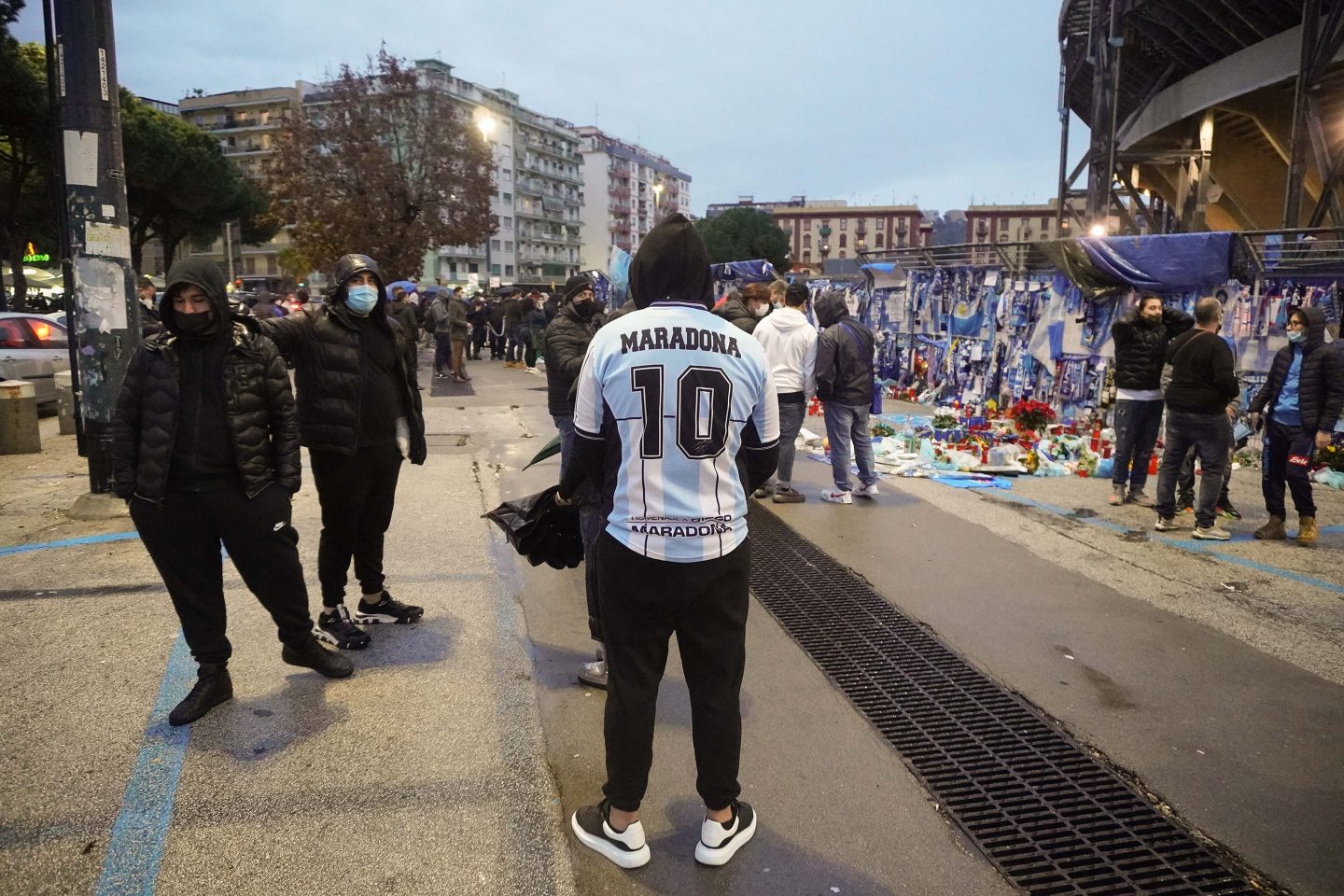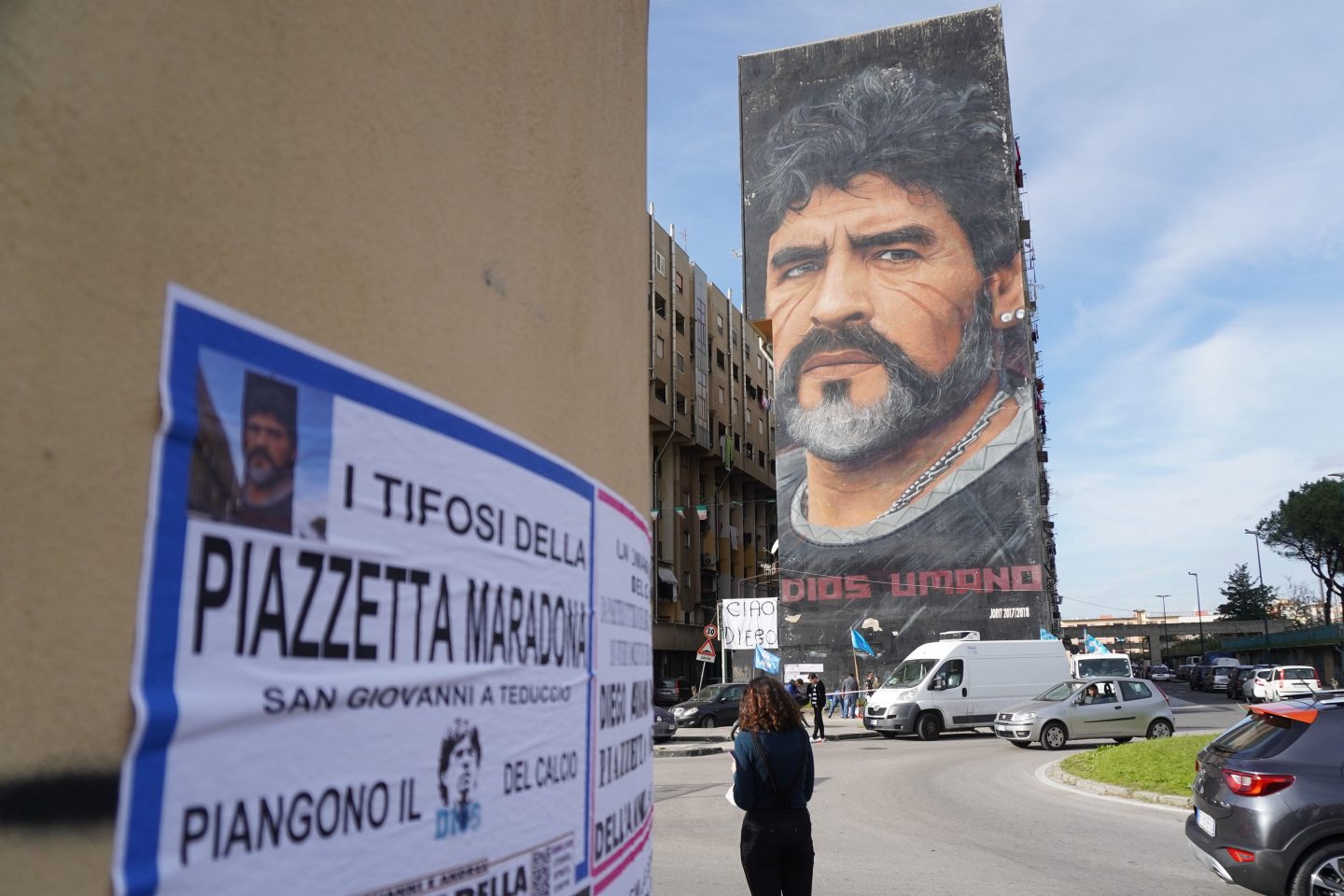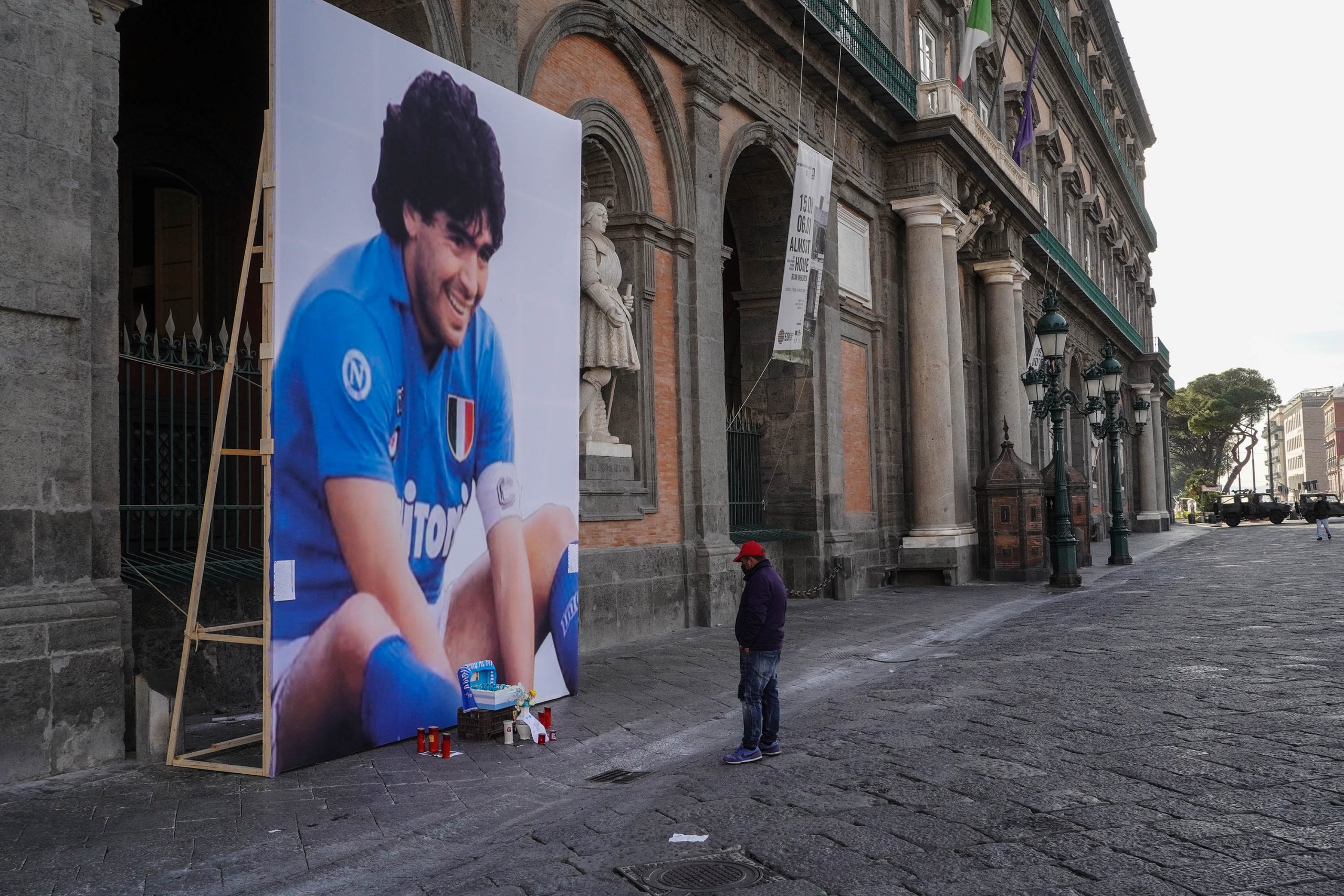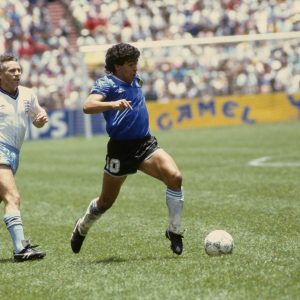Naples and Maradona: the ultimate southern comfort
Neapolitans braved Covid-19 restrictions to mourn Diego Maradona, the man who took the city from earthquake ruins to a seat at the highest table in Italian and European football.
Author:
4 December 2020

“We are sick.” These words flow out of the mouths of Neapolitans. “We have lost a family member.” Mourners flooded the streets of Naples after the death of the city’s idol, Diego Armando Maradona.
Naples has not been the same since Wednesday 25 November, when it lost a piece of its soul. “The Neapolitans, who are usually theatrical in expressing their pain, are digesting the loss of Maradona in a composed way,” says Jvan Sica, a scholar of Maradona and screenwriter of Maradonapoli, a documentary on the relationship between the Argentine and the Italian city. That relationship is almost impossible to explain in words, you have to feel it to understand it.
On 23 November 1980, an earthquake measuring 6.9 on the Richter scale devastated Irpinia, a district around the city of Avellino, 50km east of Naples. The proximity saw Naples and its surroundings significantly damaged. The city’s tourism sector suffered a downturn and the entire Naples economy was affected.

However, the post-earthquake reconstruction was never completed. Some buildings were handed over to the earthquake victims after decades. Others, originally built to house displaced people temporarily, are still standing. Like in the Soccavo area around the training centre that was home to Napoli from 1977 to 2004, the year of the club’s failure – relegated to Serie C and declared bankrupt.
The misery brought by the earthquake added to the already historically precarious situation in Naples, one of the nerve centres of southern Italy, in stark contradiction to the more prosperous industrial north. At the beginning of the 1980s, a significant socioeconomic gap, which emerged after the country’s unity in 1861 and still lingers, persisted between north and south Italy.
This is the so-called “southern question”, an expression used for the first time by congressman and journalist Antonio Billia in 1873, and then taken up and popularised in 1926 by Antonio Gramsci, one of the founders of the Communist Party.
Related article:
In the post-unification period, the Savoy governments, which held the power of the newly constituted Kingdom of Italy, wanted to establish a state and bureaucratic system similar to the Piedmontese system in the southern provinces. The abolition of uses (trusts) and common lands, taxes imposed on the population, compulsory conscription and the regime of military occupation created a situation of strong discontent in the south.
Among the plagues of this discontent, phenomena such as emigration to northern Italy or abroad, banditry and the mafia (commonly referred to as Camorra in Naples) were born. People who come from the south are often indiscriminately associated. Stereotypes, which often lead to discrimination, also concern the social class to which the populations of the south mostly belonged at the time. Terrone (Southerner) is the derogatory term with which northern natives tag their southern counterparts. Terrone, as defined in the mid-20th century, indicates a person linked to the land, or who works the land, and whose social and cultural condition is therefore considered inferior.

Maradona’s relationship with Naples
On 5 July 1984, Maradona landed in Naples, amid all of these socioeconomic conflicts. The Pibe de Oro, or Golden Boy, was presented at the San Paolo Stadium in front of about 80 000 enthusiastic spectators who that evening began to cling to an emotion that had hitherto been malnourished, almost abandoned: hope.
“What I can promise the fans is that I will leave everything I have on the pitch to be able to repay, at least partly, this great show of affection,” said Maradona. The Neapolitans trusted him, giving the Argentine unconditional love throughout his stay. They understood that Maradona could be their guide on the path to social redemption for a city that is too often politically exploited, mistreated, perhaps forgotten. They had already grasped the greatness of the man, the greatness of Diego.

Diego Armando Maradona Mollica’s father was among those in awe of Maradona’s greatness. Despite Napoli sitting in eighth place in Maradona’s first season, he named his son after the talented Argentine.
“My father says, ‘I either do things well or I don’t do them at all’,” says Mollica. It is estimated that there are many families who, during the 1980s and beyond, gave their children the name Diego or Diego Armando.
“I know I am the only person to bear the full name of the Pibe de Oro,” says Mollica.
Maradona, that 5 July 1984, brought with him a light that would illuminate the path of the city for the following seven years, leading Napoli to victories with magical performances and restoring pride to South Italy. His performances transcended the pitch. It meant they prevailed over the contempt and discrimination of the northern regions, against the abuse and arrogance of the most powerful teams. Against anyone who offended Naples and its inhabitants.
Related article:
“There was a clear feeling that the south couldn’t beat the north,” Maradona famously said. “We went to play against Juventus in Turin and we scored six [five actually, in Juventus-Napoli 3-5 on 20 November 1988]. Do you know what it means when a southern team scores six to the lawyer Agnelli?” Giovanni Agnelli was the chair of Juventus and president of the Fiat car company, making him one of the main exponents of northern industrialism. He was known as L’Avvocato, or The Lawyer.
At the centre of Naples, Eugenio, mourning like other Neapolitans, pointed to a street sign reading “Salita Maradona (Maradona Climb)”. The street was renamed after the Argentine led Napoli to its maiden Scudetto in 1987. “Maradona gave us so many smiles and so much joy in a sad moment,” Eugenio says.
“Maradona did only good in Naples,” adds Teresa Iorio, a pizza maker who is indifferent to football but a lover of Maradona. “We love the man, Diego, and no matter the mistakes he made. We all fall into weaknesses and we must not judge.”
“Maradona, like all artists, has influenced our life. It showed a new reality and gave hope to the Neapolitans,” Sica says. And he did so without ever betraying the soul of Naples, anarchic and unruly. A soul that he fully embraced because, after all, it was also his.
-

-

Street artist Jorit mural + obituary
For Naples, Maradona meant liberation, rescue, redemption and indeed proof that the south can defeat the north and prosper, even economically. Sporting successes achieved with the Argentine accelerated the development of the Fuorigrotta area, home to the stadium that will soon officially take the name of Diego Armando Maradona.
“Everyone knows that Maradona has allowed many people to build their homes,” says Sica.
“That’s why we remember Maradona, who will remain forever in Naples. Because Maradona is Naples,” says Mollica.
And that’s also why Naples, like Buenos Aires, still struggles to believe Maradona has died.
Mourning the city’s idol
After the news of his death, a veil of pain covered the city. Candles showed up everywhere, but souls switched off. Naples feels terribly empty. As do the streets of San Gregorio Armeno, the heart of the traditional Christmas stalls, nativity scenes and football players’ statuettes. In the days that followed, only a few smiling Nigerian guitarists broke the composure of a place usually full of sound and colour. “We are all dead inside,” admits a newsagent as he lowers his head, as if to hide the sadness that surrounds his words.
The love between Maradona and Naples was mutual. “He was often forced to bandage his wrist because he signed thousands of autographs,” says Alessandro Renica, Maradona’s teammate in Naples between 1985 and 1991. A love that Neapolitans wanted to celebrate, despite the restrictions imposed by the government owing to the pandemic.
Naples is a red zone, but even Covid-19 couldn’t stop Neapolitans. Thousands of people flocked to the streets of the symbolic places of Naples to pay homage to the 1986 Fifa World Cup winner.
Maradona left Naples in 1991, but his presence and spirit remains in the city. Diego is on walls, on balconies and in shops all over Naples.

With that impact, it was inevitable that the outside of the city stadium would turn into a huge shrine in honour of the man who changed the lives of hundreds of thousands of people. Outside Curva B, a father places his gift on the entrance gates and kneels, hands crossed, to pray to his god, the god of Naples. Then when he gets up, he is joined by his son who also paid tribute to Maradona, before his father urges him to shout the footballer’s name as he has done.
“I lost a partner who made me dream,” says Neapolitan Massimiliano Favo, Maradona’s teammate between 1984 and 1986. “This wave of emotion is because Maradona was one of the people. He entered the heads of ordinary people because he always said what he thought and always stood as a champion of the most needy and the weakest. In him there was a mixture of personality, humanity and genius that no one has ever had in football.”

Favo, whose most enduring image of Maradona comes from their famous 1-0 victory against Juventus, says, “Diego, in addition to letting us freely choose the shoes that were provided to him by his sponsor, always came to us to make sure that the percentage of the prize for the youngest players was correct. He always asked us if we needed anything, even the car to go out with our girlfriends.
“After the goal versus Juve, seeing Diego crying in a city that’s not his city, with his family, for giving satisfaction to the Neapolitan people against the most hated team, is indescribable.”
Maradona’s influence on Naples is explained even better by what Favo’s father, a serious 81-year-old who tends to keep everything to himself, did after the Argentine died. “After an hour from the news, he called me and asked how I am. He told me, ‘I feel like crying,’ and started to cry. Him, who never gave me a kiss.
Related article:
“Maradona made my father’s generation feel stronger, he made them have fun. For us he was a leader, a Masaniello,” says Favo, referring to the protagonist of the Neapolitan revolt from 7 to 16 July 1647 that saw the population of the city rise up against the tax burden imposed by the Spanish viceregal government. “But unlike Masaniello, he never let himself be bought. And we who have had the good fortune to live with him, have handed down these emotions to the following generations.”
This informed Salvatore Cierro’s decision to get a tattoo of Maradona’s face on his right shoulder. Cierro, 28, was born the year after the Argentine’s departure and is one of the promoters of the Centro Paradiso Committee, which is pushing for the redevelopment of the Soccavo Sports Centre, where Napoli trained. The plan is to transform the centre into a museum dedicated to the Argentine. “I grew up with my father’s VHS tapes showing Maradona’s exploits on the pitch and absorbed Naples’ love for him,” says Cierro.
Naming a square and a metro stop after him, and thinking about the creation of a statue of Maradona, are tributes that define the space Maradona has taken in the hearts of Neapolitans. But there is more, because Maradona was more.
He was an extraordinary man who gave and will give life to actions and initiatives that are just as out of the ordinary, like the one that came to Sica’s mind. In partnership with the University of Salerno’s professor of sociology of cultural processes Alfonso Amendola and the writer and journalist Elio Goka, launched the Maradonian Research Centre on Thursday 3 December in order to preserve Diego’s memory over time and help Naples rediscover their hope or find a new emotion to fill the void that still, a few days after Maradona’s death, invades the city.
Update, 7 December 2020: On 4 December, Naples’ city council confirmed the renaming of the San Paolo Stadium to the Diego Armando Maradona Stadium.




